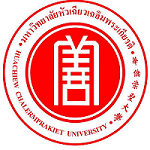Please use this identifier to cite or link to this item:
https://has.hcu.ac.th/jspui/handle/123456789/4853| Title: | รูปแบบการพัฒนาการคิดอย่างมีวิจารณญาณในการเรียนรู้ศิลปะสมัยใหม่และร่วมสมัยของไทยในพิพิธภัณฑ์ศิลปะ |
| Other Titles: | Model of Critical Thinking Development in Thai Modern and Contemporary Art Learning in Art Museums |
| Authors: | ปทุมมา บำเพ็ญทาน Patumma Bumpentan Huachiew Chalermprakiet University. Faculty of Communication Arts |
| Keywords: | ความคิดอย่างมีวิจารณญาณ Critical thinking ศิลปะสมัยใหม่ Arts, Modern ศิลปกรรมสมัยใหม่ -- คริสต์ศตวรรษที่ 21 Art, Modern -- 21st century พิพิธภัณฑ์ศิลปะ Art Museums การเรียนรู้ Learning ศิลปะร่วมสมัย |
| Issue Date: | 2019 |
| Abstract: | การวิจัยมีวัตถุประสงค์ 1) พัฒนารูปแบบ และ 2) ศึกษาผลการใช้และนำเสนอรูปแบบ การดำเนินการวิจัยแบ่งเป็น 2 ระยะ 1) การศึกษาข้อมูลพื้นฐานสำหรับพัฒนารูปแบบ 2) พัฒนารูปแบบโดยสังเคราะห์ข้อมูลวิจัยระยะที่ 1 ทดลองใช้ร่างและประเมินความเหมาะสมและความเป็นไปได้ของรูปแบบจากกลุ่มผู้ทรงคุณวุฒิ และ 3) การใช้รูปแบบกับตัวอย่าง 2 กลุ่ม กลุ่มละ 50 คน ในนิทรรศการที่เนื้อหาแตกต่างกัน ด้วยแผนการทดลอง 2 กลุ่ม วัดผลหลังกิจกรรม และนำเสนอรูปแบบ วิเคราะห์ข้อมูลด้วยการหาค่าความถี่ ค่าเฉลี่ย ส่วนเบี่ยงเบนมาตรฐาน ทดสอบค่า t และวิเคราะห์เนื้อหา
ผลการวิจัยระยะที่ 1 พบว่า พิพิธภัณฑ์ควรกำหนดจุดมุ่งหมายในการจัดกิจกรรมการศึกษาเพื่อพัฒนาการคิดอย่างมีวิจารณญาณ โดยเน้นเนื้อหาเกี่ยวกับประวัติศาสตร์ รูปแบบและแนวคิด คำนึงถึงความเหมาะสมกับนักเรียน ให้ได้ทำความเข้าใจ แสดงความคิดเห็น และสร้างสรรค์ผลงานศิลปะ
รูปแบบที่พัฒนาขึ้นเป็นกิจกรรมการศึกษาเพื่อพัฒนาการคิดอย่างมีวิจารณญาณในการเรียนรู้ศิลปะในพิพิธภัณฑ์เชื่อมโยงมิติการคิด 3 ด้าน คือ ด้านองค์ประกอบ มโนทัศน์ และประวัติศาสตร์ศิลปะ ผ่านกระบวนการทำความเข้าใจ อภิปราย และสร้างสรรค์ศิลปะ ผลการใช้รูปแบบสรุปว่า 1) ผลการประเมินการคิดอย่างมีวิจารณญาณของนักเรียนที่ร่วมกิจกรรมโดยภาพรวม 2 กลุ่ม มีค่าเฉลี่ยในระดับการคิดที่มีสมรรถนะ 2) เปรียบเทียบคะแนนประเมินการคิดอย่างมีวิจารณญาณระหว่างตัวอย่าง 2 กลุ่มพบว่า คะแนนรวมของตัวอย่าง 2 กลุ่ม แตกต่างกันอย่างมีนัยสำคัญทางสถิติที่ระดับ .05 The purposes of this research were 1) to develop a model and 2) to study the effects of the model and present the model. The research was divided into three phases: 1) Studying fundamental information for develop the model 2) Developing the model and evaluating propriety standards and feasibility standards from experts and 3) Implementing the model with 2 samples, 50 students in each group, in different art exhibitions. The study used two-group posttest only design. The data were analyzed by using frequency, means, standard deviation, independent samples t-test and content analysis. The findings from the first phase were the museums should determine the objective of educational activity to develop critical thinking. The contents activity should focus on art history, elements of art, and concept. The activity should be appropriate for the level of the students to understanding works of art, discussing about art, and creating artwork. As the result of learning model development, the principle of the model was educational activity to develop critical thinking in art learning in art museums. Connecting with 3 dimensions of thinking: form, concept and art history. There were 3 components of the learning process: understanding works of art, discussing about art, and creating artwork. The results were as follows: 1) the overall mean score for critical thinking evaluation of 2 samples were in competent level. 2) Comparing the overall mean scores between 2 samples in different art exhibitions showed that there was a statistically difference between 2 samples at the significant level of 0.5. |
| Description: | Thailand Research Expo : Symposium 2019 “มหกรรมงานวิจัยแห่งชาติ 2562 (Thailand Research Expo 2018) ในระหว่างวันที่ 7-10 เมษายน 2562 ณ โรงแรมเซ็นทาราแกรนด์ และบางกอกคอนเวนชันเซ็นเตอร์ เซ็นทรัลเวิลด์ กรุงเทพฯ จัดโดย สำนักงานคณะกรรมการวิจัยแห่งชาติ (วช.) |
| URI: | https://has.hcu.ac.th/jspui/handle/123456789/4853 |
| Appears in Collections: | Communication Arts - Proceeding Document |
Files in This Item:
| File | Description | Size | Format | |
|---|---|---|---|---|
| Model-of-Critical-Thinking-Development-in-Thai-Modern-and-Contemporary-Art.pdf Restricted Access | 685.62 kB | Adobe PDF | View/Open Request a copy |
Items in DSpace are protected by copyright, with all rights reserved, unless otherwise indicated.
